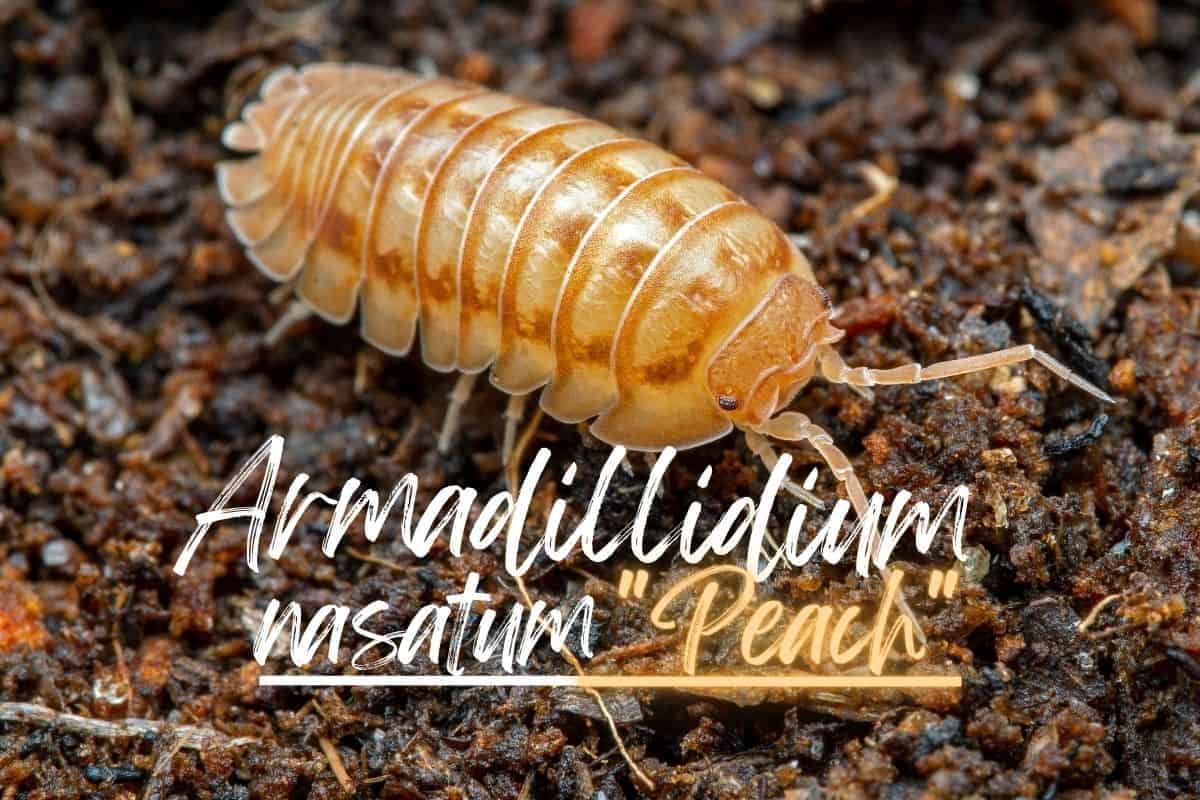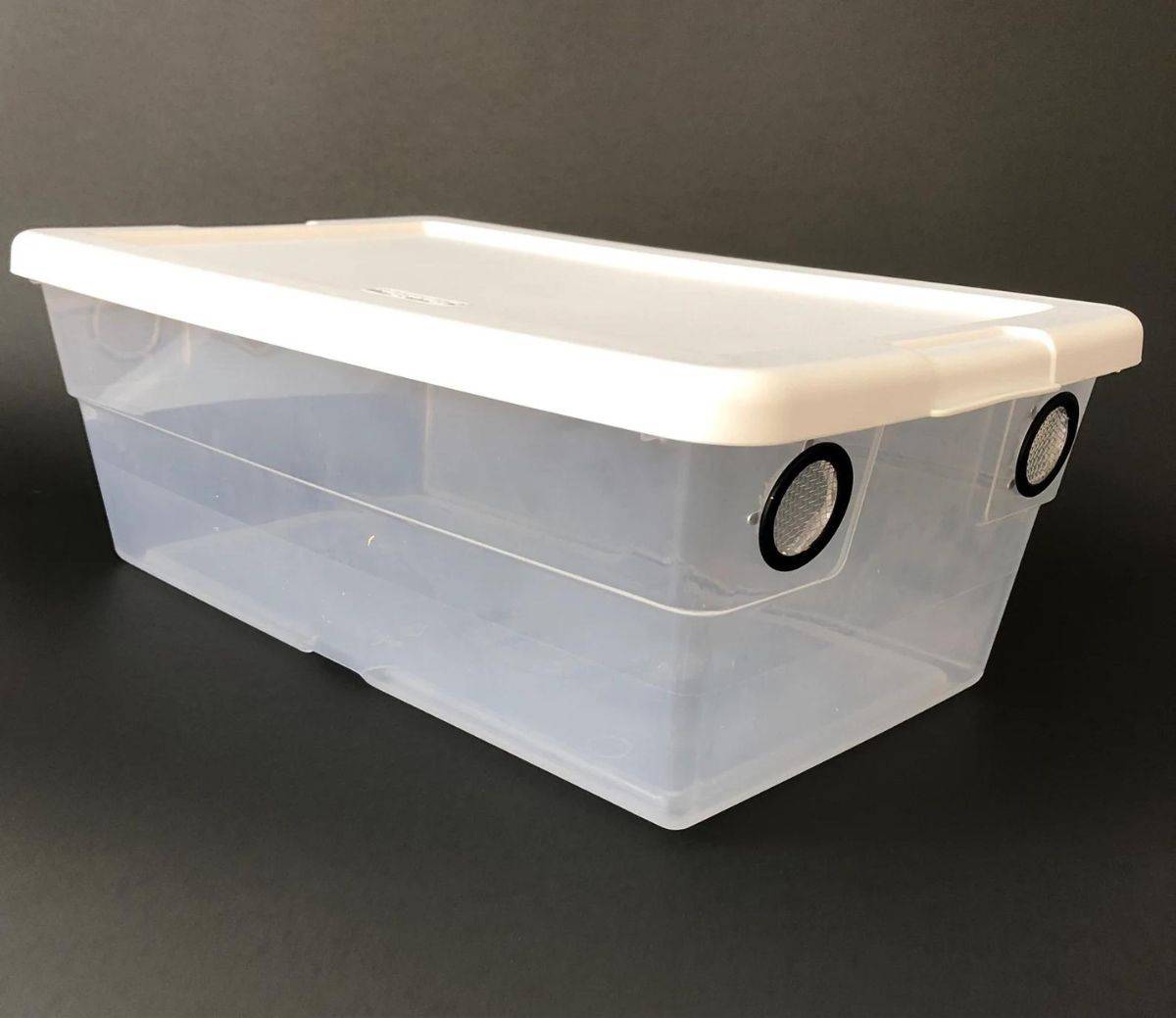Armadillidium nasatum “Peach” is an isopod with a wonderful combination of style and function.
Prized for its lovely soft coloration and easy care, it’s commonly used as both a beginner isopod pet and as a bioactive cleanup crew. Seriously, these little beauties can do it all.
This variety is also one of the most affordable on the market (which is to be expected from one of the most successful isopod species on the planet).
So there really is nothing to stop you from giving them a go!
In this article, we’ll cover everything you need to know about Armadillidium nasatum and how to use them in your next project.

Terrarium Tribe is reader-supported. When you purchase through links on our site, we may earn an affiliate commission (at no further cost to you). 💜
Armadillidium nasatum 101
Armadillidium nasatum is a versatile isopod, both in adaptability and aesthetics.
Commonly found across Europe, North America, and (from the literature) seemingly found all the way down in Uruguay1 too. It appears that this isopod is quite a capable species, and it’s fair to assume that it’ll do well in a range of terrarium/home environments too.
Visually, the dark grey wild-type (the common form) of A. nasatum is a lot like its native isopod cousin, Armadillium vulgare.
But there are a couple of unique features to look out for.
- They have a characteristic “nose” protrusion on their face, which gives rise to the common name, the “Nosy Roly Poly.” Though it’s not the easiest thing to spot from up high.
- Thankfully, there’s also a pale striping pattern that runs down the full length of the body.
The wild type is found commonly for sale, but there’s another variety that’s really made a mark in the isopod hobby, and that’s the “Peach.”
👉 Shop the Armadillidium nasatum ‘Peach.’
Bioactive Terrarium / Vivarium Uses
As you’d expect from an isopod that’s colonized much of the Western world, Armadillidium nasatum is able to handle a wide range of terrarium environments – from humid tropical to semi-arid setups.
Naturally, this makes them a great species choice for bioactive setups.
Interestingly, a study on isopod crowding2 found that the growth rate of Armadillidium nasatum was positively affected by the presence of large animals.
Which is a very handy trait when you’re trying to populate a setup.
So you can be sure they’ll make a good pairing for bioactive vivariums too, cohabiting with the likes of reptiles and frogs.
Of course, as a medium-sized isopod species (up to around 1.5 cm fully grown), they may well become a snack for larger vivarium animals. But their easy care and fairly prolific breeding will help them keep up and maintain a stable colony.
Now, on to how to care for these adaptable critters.
Armadillidium nasatum Care
Habitat & Conditions
Setting up an isopod culture for Armadillidium nasatum should be super straightforward.
For starters, they’re a medium-sized species, and they love to hang out together, so there’s no need to give them tonnes of space. As with many isopods, a shoebox-sized container is a solid place to start here.

Plus, they’re a hardy bunch, so you likely won’t need to provide any specific conditions for them.
According to the experts at Rubber Ducky Isopods, this species does best between 65-85º F (18-29º C). So that’s a nice easy household temperature range to work with.
Based on their success in environments like temperate UK forests, it’s understandable that they’d do well in relatively humid conditions. Look to maintain 50%+ humidity, and they’ll be absolutely fine on that front.
An isopod substrate setup that can provide a moderate moisture gradient (i.e., retain some moisture in some areas) will help to generate that humidity.
Just don’t overdo it… this species won’t thrive in a really damp, humid enclosure.
Food
Armadillidium nasatum doesn’t appear to be a picky eater.
Honestly, that’s part of what makes them such good bioactive custodians. In a terrarium or vivarium, we want them to eat anything and everything organic that’s not our plants or animals!
For simple cultures and bioactive setups alike, the standard isopod diet of decomposing wood and leaf litter is a must (you can grab a bag of Organic Leaf Litter here).
Plus, you can supplement with scraps of vegetables whenever it’s convenient for you.

Alternatively, an Isopod Super-Food mix is the easiest way to cover all your bases.
As with all of the Armadillidium species, an added calcium source is much appreciated. It’s going to help with their exoskeleton development (and can later help to produce a calcium-infused snack for your reptiles).
So you can pop a bit of cuttlebone or eggshells in there for a little boost.
Breeding
These isopods are reasonably prolific breeders, so you can expect them to populate a new setup without much interference.
As mentioned earlier, they’ve been found to breed well in animal vivariums too.
Though these isopods can handle more arid environments, if you’re looking to maximize the breeding rate and survival of the young, increasing moisture and temperature can help.
Armadillidium nasatum Varieties
According to another study3, there are six “pure breeding” color morphs. Though, in the hobby, there are only really four that are available to buy.
- “Peach” is technically the orange expression of the species, but it’s definitely more of a peach color.
- “Pearl” is the dalmatian variety of this isopod. Displaying a clear white shell with subtle black flecks.
- “Whiteout” is the albino morph with white eyes and completely white bodies.
- Then, of course, there’s the simple grey wild-type too.
For something similarly orange – and equally effective in terrariums – check out the Porcellio scaber ‘Orange Koi’ variety.
Where to Buy Armadillidium nasatum “Peach” & Others
Nowadays, it’s very easy to source Armadillidium nasatum “Peach” and others online.
You can grab a colony of 10 perfect peaches from our partners, Rubber Ducky Isopods. 👇 They really know their stuff and take every care to make sure your colony arrives safely and healthy.
👉 Shop Armadillidium nasatum ‘Peach.’
And with your new set of juvenile isopods, you’ll get a neat little starter kit to get you started on the right foot.
What’s Next?
For more Armadillidium inspiration, check out the funky Clown Isopods.
Or how about the Powder Orange Isopods for yet more vibrant citrus-colored isopods?
References
